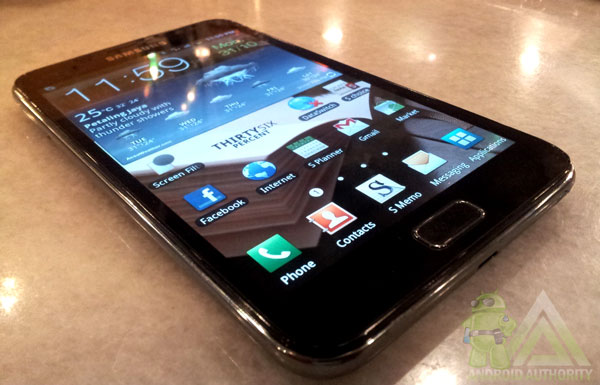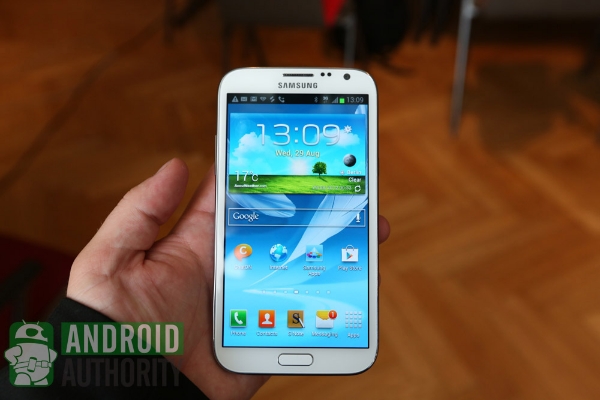
If you could only use two words to describe the Samsung Galaxy Note series, they would likely be “big” and “expensive.” Regardless of the Note phone you’ve owned, they’re all enormous compared to almost all of their contemporaries and come with premium price tags to match. In this article looking at the history of Samsung Galaxy Note prices, we’re going to only focus on the “expensive” part.
Granted, the size of Note phones is what put them on the map. When the first Galaxy Note launched in 2011, people mocked it for how large it was. This created a strange kind of press for the phones, which helped them sell incredibly well for a new line. Looking back, the phone wasn’t even that big. It had a 5.3-inch display housed in a body shorter than the Samsung Galaxy S20, although the Note was considerably wider and thicker.
The Galaxy Note line is the reason we have phones as big as they are today. Whether that’s a good thing or a bad thing is up to you.
As phones have grown in size, so has the price of Galaxy Note phones. While they were never cheap, there’s been a very steady rise in price every few years. Below, we’ve compiled information on pricing for the Note series. We’ve also given insight into what makes each Note different from its predecessor.

When the first Samsung Galaxy Note phone launched, the smartphone industry was a wholly different animal. So, comparing the manufacturer suggested retail price (MSRP) of a Galaxy Note with the MSRP of the Galaxy Note 10 isn’t really an apples-to-apples comparison.
As an example of this, the first Galaxy Note phone was an AT&T and T-Mobile exclusive in the United States, and you couldn’t buy it off-contract. In order to get one, you’d pay $299 as a down payment, and then pay off the rest of the price over a two-year period. Other regions around the world didn’t have this limitation. For example, an unlocked Note in the UK cost £500 in 2011.
Since 2011, the smartphone industry has changed a whole lot, making apples-to-apples pricing comparisons tricky.
Samsung gave US carriers the freedom to choose their own pricing on the second- through the fifth-generation models of the Galaxy Note phones. This resulted in wildly different prices. As an example, the Galaxy Note 4 cost $825 unlocked at AT&T and just $700 from Verizon.
It wasn’t until the Samsung Galaxy Note 7 that things got (mostly) consistent, and Samsung made it easy for everyone to buy unlocked models directly from its online store.
On top of the pricing and availability discrepancies, there were also different models and even designs of Note devices around the world. This meant that an original Galaxy Note from AT&T looked and functioned differently than the unlocked one for sale in the UK. We saw this same confusion in the Galaxy S line.
Related: Unlocked phones: The pains and pleasures
With all that in mind, the pricing below is based on availability in the US and uses the lowest price available to the general consumer at the phone’s launch. That means, in the specific case of the previously mentioned Galaxy Note 4, we went with the $700 Verizon price and not the $825 AT&T price.
One final note: we are not including “side” devices in our Samsung Galaxy Note prices roundup. This means phones such as the Galaxy Note 3 Neo and Galaxy Note FE aren’t included here. We’re only focused on the “prime” devices in the main lineup.

The original Samsung Galaxy Note was one of the very first phones to earn the “phablet” moniker. It was too big to be a phone, but too small to be a tablet. In our original hands-on with the device, we stated that just using a phone of its size took some getting used to. Nowadays, the Galaxy Note looks downright small compared to most major flagships.
The Samsung Galaxy Note had a 5.3-inch display with a 1,280 x 800 resolution, which was quite high for the time. With a headphone jack, a microSD slot, the now-iconic S Pen, and specs that beat nearly every other smartphone of its day, the original Note was a power user’s dream.
Unfortunately, the phone wasn’t easy to get. You needed to be an AT&T or T-Mobile customer as well as sign up for a two-year commitment. With a down payment of $299, the Note was $100 more expensive than the entry tier iPhone 4S, which came out that same year on a similar down-payment plan.
Despite that, the original Note sold well. Samsung announced it moved 10 million units after just nine months.

With the unexpected success of the original Note, one would have expected Samsung to pull out all the stops for the follow-up in 2012. However, the Samsung Galaxy Note 2 only got a slightly bigger display, a better processor, and a marginally improved S Pen, but not many other upgrades.
Samsung also tweaked the design language of the device to make it look almost identical to the incredibly popular Samsung Galaxy S3, which launched earlier that same year. This wouldn’t be the last time Samsung followed similar designs from its other smartphone lines when it comes to the Note.
Related: The original Samsung Galaxy Note 2 review from Android Authority
Interestingly, Samsung didn’t change much on Galaxy Note prices. The Galaxy Note 2 was available for the same $299 down payment price as its predecessor. However, this time all of the big US carriers were on board with Verizon, Sprint, US Cellular, and more selling the phone. AT&T even dropped the price of the original Note to $199 and continued selling both devices.
Keeping the pricing the same for the Samsung Galaxy Note 2 is likely one of the factors that helped it soar past the 10-million-unit record of its predecessor. After one year on sale, the Galaxy Note 2 moved 30 million units.

In 2013, the Samsung Galaxy Note 3 finally made it possible for people to buy a Galaxy Note phone outright from some carriers. However, unlike Apple, Samsung didn’t require the carriers to sell the phone at any particular price point. This resulted in a very confusing pricing structure that wouldn’t get corrected for a few more years.
Related: The original Samsung Galaxy Note 3 review from Android Authority
As an example of how the Samsung Galaxy Note prices were getting confusing, let’s assume you wanted to buy a Note 3 from T-Mobile. You would’ve paid $200 upfront and then $21 each month for two years, resulting in a total price of $704. With AT&T, you could pay $300 down with a two-year commitment, $550 down with a one-year commitment, or you could pay $725 upfront. Walk to the Verizon store instead, and the phone would cost you $700.
Unlocked pricing from third-party retailers was also inconsistent, but most listings had the Galaxy Note 3 for at least $750 during its first months. It was chaos.
However, the upgraded specs and new design elements of the Note 3 — including a faux leather back and faux metal rim — helped it sell well. Within just two months, Samsung moved 10 million units, a feat that took the original Note nine months to do.

02/08/2020 03:30 PM
02/08/2020 11:00 AM
02/08/2020 11:00 AM
02/08/2020 02:30 PM
02/08/2020 04:52 PM
02/08/2020 10:00 PM
02/08/2020 02:40 AM
2014 © Canadian apps and news